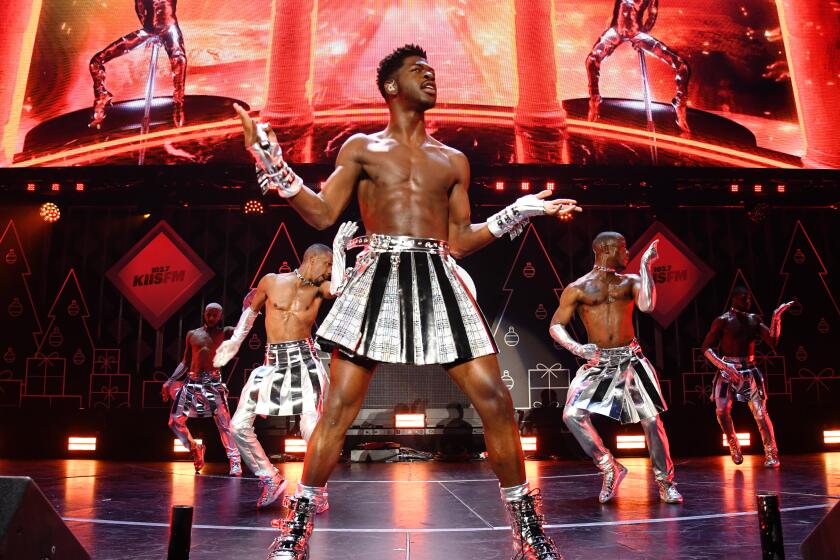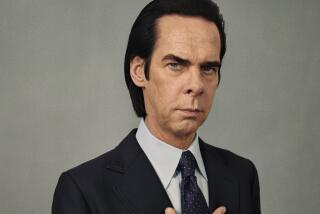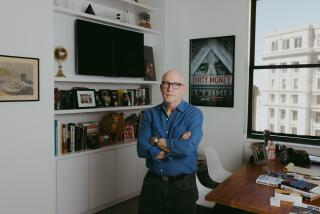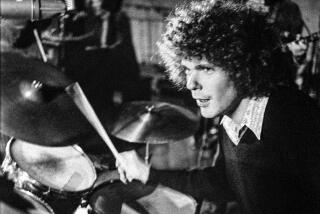How Jim Morrison’s final sessions with the Doors produced an L.A. classic out of chaos
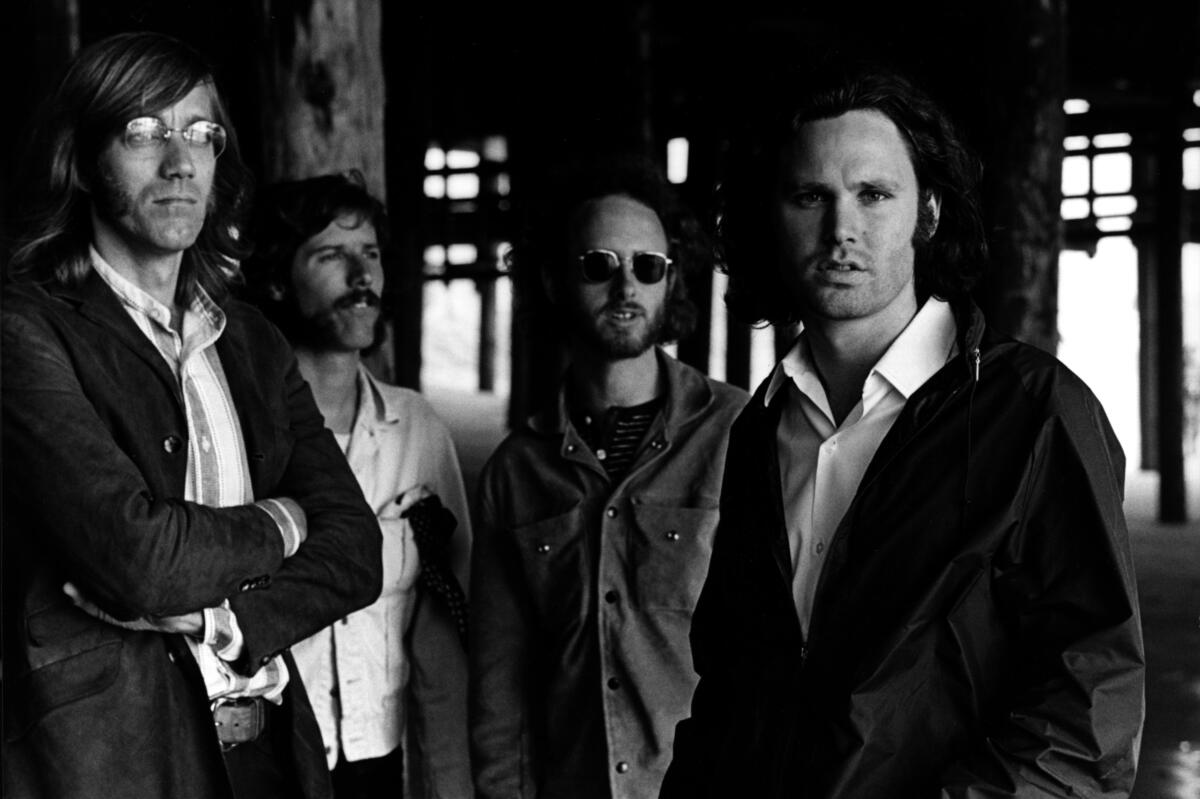
During the period in late 1970 and early ’71 when Jim Morrison and his bandmates in the Doors were recording their sixth and final studio album, “L.A. Woman,” at their West Hollywood rehearsal space, the singer was drowning in a booze-fueled bender: drunk nearly every night but sober by morning and ambling across Santa Monica Boulevard for the day’s session.
“When he got too drunk, he would become kind of an a—,” recalls Doors guitarist Robby Krieger of Morrison during the “L.A. Woman” sessions, on the phone from his home in Benedict Canyon. “It got harder and harder to be close with him. He’d have his drinking buddies, and we were always trying to keep them from being together.” Krieger’s new memoir, “Set the Night on Fire: Living, Dying, and Playing Guitar With the Doors,” doesn’t pull any punches when it comes to Morrison’s dark side, nor does it minimize his creative light.
“L.A. Woman” is the subject of a new reissue from Rhino Records. Called “L.A. Woman: 50th Anniversary Deluxe Edition,” the physical set features a remaster of the album by original co-producer Bruce Botnick, two discs’ worth of fascinating studio outtakes, extensive liner notes and a vinyl copy of the original stereo mix.
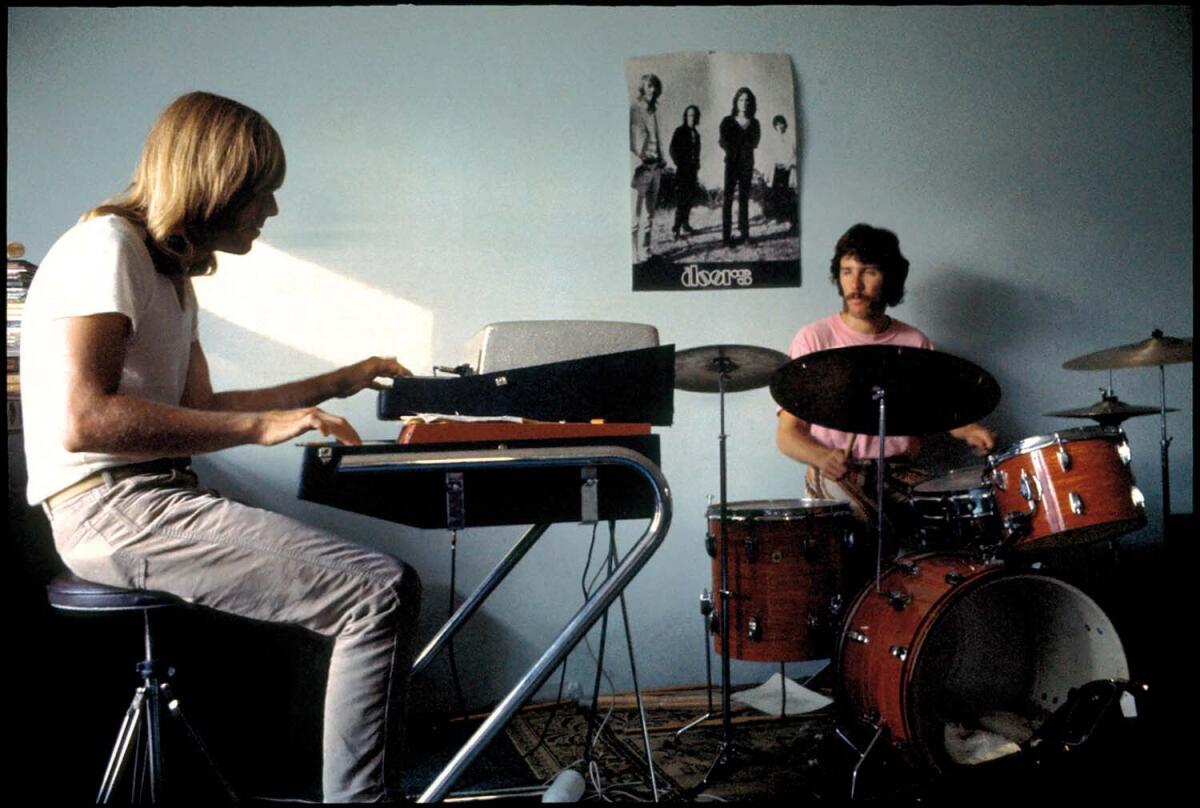
That Morrison, Krieger, drummer John Densmore and keyboardist Ray Manzarek managed to create “L.A. Woman” wasn’t a foregone conclusion. After all, Morrison was the kind of guy who, after entering the Empire State Building in 1969 for a tour and boarding a crowded elevator, “swiped his hand across all the buttons, to the annoyance of all the other passengers who then had to wait as the elevator stopped at every single floor,” Krieger writes in his memoir.
But the musicians were locking in at rehearsals and Morrison was writing, Krieger says. “Jim would stay in this crappy motel called the Alta Cienega, which was right across the street. That was good, because getting Jim to show up for recording sometimes wasn’t easy. This time, because he was so close, he was usually the first one there.”
By then, he’d become a certified rock star. Each of the Doors’ earlier albums, including their early 1967 self-titled debut and their fall follow-up, “Strange Days,” had gone platinum, though none had hit No. 1 until their third, “Waiting for the Sun,” and its smash, “Hello, I Love You,” in 1968.
The Pakistan-raised, Brooklyn-based artist, who sings mostly in Urdu, received two Grammys nominations, including best new artist.
Initially tentative during their early years at the Whisky A Go Go, by the time the Doors released “Morrison Hotel” in early 1970, Morrison and his bandmates had toured incessantly. Morrison’s writhing, explosive performances made headlines, and were way wilder than those of pop-oriented L.A. peers the Byrds, Joni Mitchell or the Mamas and the Papas. (As he was becoming Iggy Pop, young fan James Osterberg drew inspiration from Morrison at a Doors concert.)
Morrison had been increasingly tanked onstage across the band’s two dozen shows in 1970, where the Doors were playing their hits alongside blues classics including Junior Parker’s “Mystery Train,” Willie Dixon’s “Back Door Man” and John Lee Hooker’s “Crawling King Snake,” which they’d end up recording for “L.A. Woman.”
“Jim loved singing the blues, especially when he was inebriated,” says Botnick on the phone from his studio in Ojai.
At the Doors’ disastrous Dec. 12, 1970, tour stop in New Orleans — Morrison’s final concert — the rest of the band bailed on Morrison midset due to his narcissistic between-song tirades; at one point he told a misogynistic joke about a blind man passing a fish market and rambled on to a bored, restless crowd. During a stop in Dallas the night before New Orleans, they’d debuted then-new song “Riders on the Storm” and it had sounded great. “We thought, ‘Wow, we’re going to be a cool rock jazz group,’” says Densmore. “Then the next night Jim was so drunk it was terrible. I hated the erosion.”
The drummer, who last year published “The Seekers: Meetings With Remarkable Musicians (and Other Artists),” hoped that by returning to L.A. they could gather themselves and figure out how to help Morrison. “I thought, ‘F— man, if we don’t get an album or two more out of Jim, so what? Maybe we’ll save his life.’”
Their longtime producer Paul A. Rothchild, who at the time was mourning the October death of close friend Janis Joplin (he oversaw her album “Pearl”), had produced the Doors’ most popular songs, including “Light My Fire,” “People Are Strange” and “Love Me Two Times.” He was scheduled to return for “L.A. Woman” but bowed out before the sessions really began. Included among the outtakes and demos is a recording of early attempts at “Riders on the Storm,” which are said to have prompted Rothchild to dismiss the song, and the band’s direction, as “cocktail jazz.”
Krieger disputes this telling of Rothchild’s departure, though. “The real reason was that he’d just done Janis and then she died. He had the feeling that something might happen if he produced our album.” Rothchild, continues Krieger, “didn’t want to be known as the guy who produced somebody and then they died.”
Aiming to record in a comfortable spot instead of their usual Sunset Sound, Botnick and band set up a studio at their rehearsal space, called the Doors Workshop, at 8512 Santa Monica Blvd.
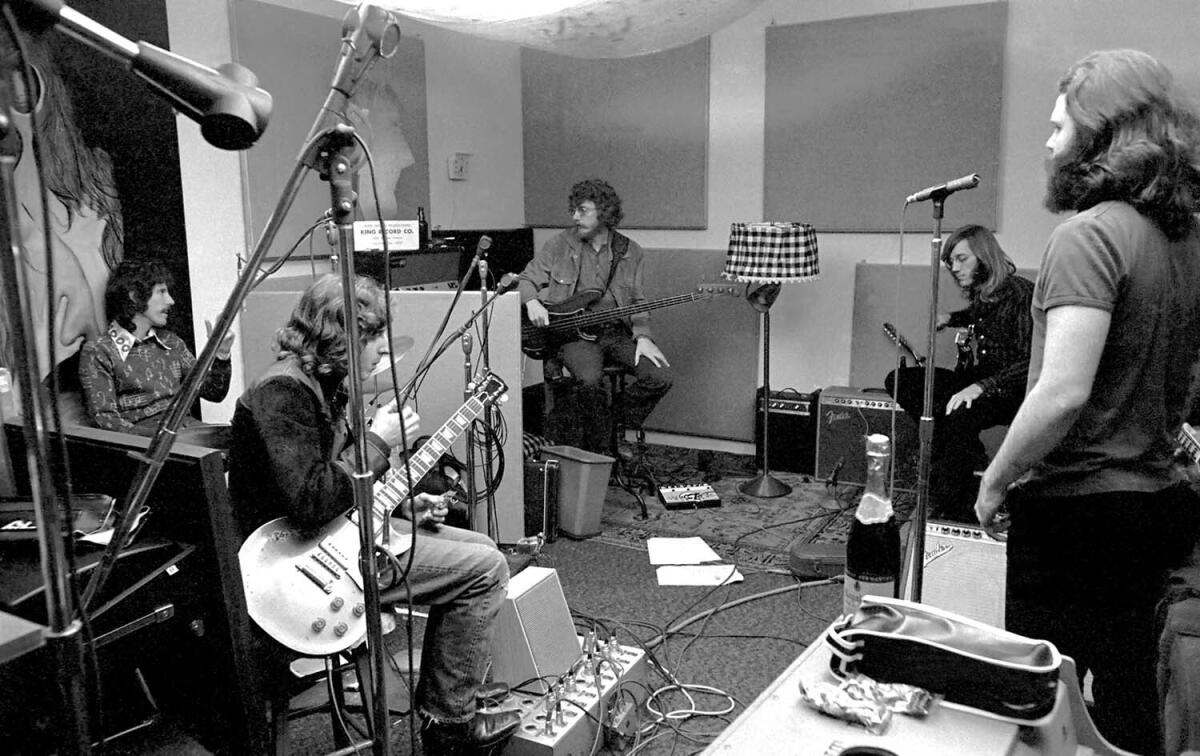
Morrison’s return from touring meant the reemergence of his enabling sycophants. In his 1998 memoir, “Light My Fire: My Life With the Doors,” Manzarek described these hangers-on as “reprobates, degenerate descendants of indentured servants, slimeballs, and general Hollywood trash.”
“On Sundays, when we were off, he would go to bars, get drunk, and crash his car,” wrote Manzarek.
Still, somehow from this chaos came one of the great songs about Los Angeles.
“’L.A. Woman’ is in three parts because we didn’t get it all at once,” Botnick recalls of the process. “It was a fairly complicated song, and to get it to sound uncomplicated took a little bit of woodshedding.” The new 50th-anniversary edition includes all 40 minutes of the band’s recorded attempts at nailing “L.A. Woman.”
“That album was the first time that we actually wrote songs together as a whole band,” says Krieger, noting that to free themselves up musically they had hired bassist Jerry Scheff, who was then in Elvis Presley’s TCB Band, and rhythm guitarist Marc Benno. For the title track, “I was free to play my leads without having to overdub them later,” explains Krieger. “Jim was singing in the bathroom, and he could hear everybody.”
At the annual radio conglom’s parade of pop stars, BTS got the most shrieks, while Doja Cat and Lil Nas X proved ready to headline arenas on their own.
What Morrison wrote and sang attempted to capture the essence of Los Angeles through an extended metaphor:
I see your hair is burning
Hills are filled with fire
If they say I never loved you
You know they are a liar
Driving down your freeways
Midnight alleys roam
Cops in cars, the topless bars
Never saw a woman so alone.
For Botnick, “The ‘woman so alone’ is Los Angeles, and it shows what he thought of the city and how he lived in it, down to the Hollywood bungalows.”
“What’s so brilliant about Jim on ‘L.A. Woman,’” says Densmore, “was his idea of writing about our town as a woman. ‘I see your hair’s burning, the hills are filled with fire.’ ... That’s our fires.”
Across seven epic minutes, the band maneuvers through the measures as if winding along Mulholland at midnight. When the singer hits the words “Mr. Mojo Risin’” — an anagram of “Jim Morrison” — the band moves into the bedroom.
“‘Mr. Mojo Risin’ is a sexual term,” says Densmore, “so I suggested that we slowly speed the track back up, kind of like an orgasm.” The aim was to return the tempo to the same rate as when the song began. “I think I overshot it a little,” Densmore says with a chuckle.
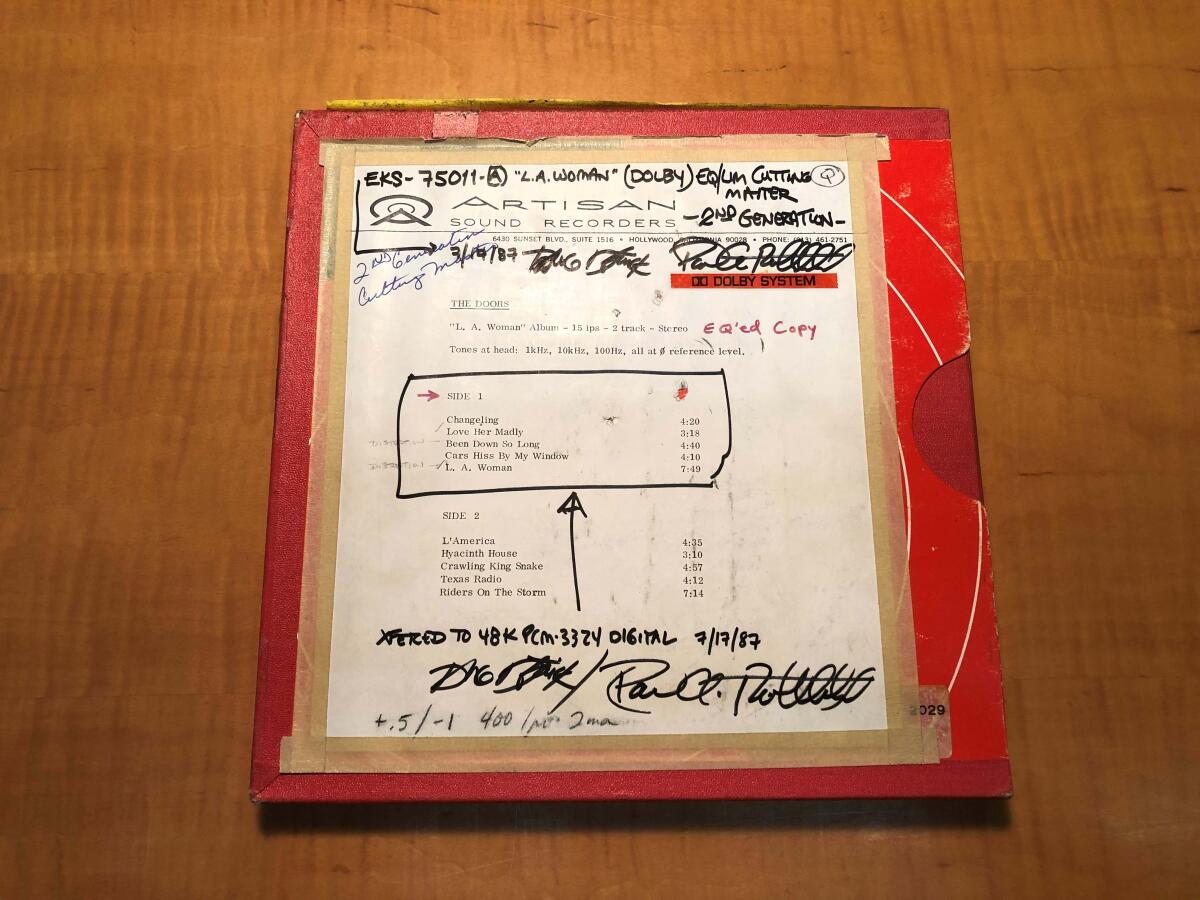
The true revelation in the demos, though, is how sober and excited Morrison sounds. Between takes on the haunting “Riders on the Storm,” he playfully starts singing the theme to the western TV show “Rawhide.” “I don’t follow orders. I’m just a dumb singer,” he says after another take.
For Krieger, hearing those outtakes offered a reminder of the ways in which musical connection manifests itself. “There’s magic in that one take,” he says. “The other ones are very similar but the magic just wasn’t there. It shows you how lucky you have to be to capture it.”
They weren’t uniformly lucky on the album, which remains a polarizing listen that often finds Morrison adopting the demeanor of a cigarette-stained prowler who boasts and moans his way through simply written blues lyrics. Capturing the tenor of Manson family-era L.A., the album’s inner sleeve included an image of a naked, lifeless woman being crucified on a telephone pole. The Doors’ label, Elektra Records, also used the illustration for an eerie Sunset Boulevard billboard. The marketing campaign worked. “L.A. Woman” sold more than 2 million copies.
Reviewing in New Musical Express upon its release, critic Roy Carr called it “one of their best in sometime,” praising it with a notably backhanded compliment: “Accusations of it being insipid, tired and monotonous are, for the most part unfounded, for many cuts on this album have great depth, vigour and presence.” “The Rolling Stone Record Guide” gave the album five stars.
Morrison’s critics, though, were many. Most memorably, critic Lester Bangs explored his allure in a 1981 essay called “Jim Morrison: Bozo Dionysus a Decade Later.”
“One thing that can never be denied Morrison,” wrote Bangs, “is that at his best (as well as perhaps his worst, or some of it at any rate) he had style, and as he was at his best as a poet of dread, desire and psychic dislocation, so he was also at his best as a clown.”
By 1971, Morrison didn’t seem much concerned with his public image. He’d nearly quit music a few years earlier to pursue poetry, self-publishing books as James Douglas Morrison. (His collected works were recently published by Harper Design.) With the “L.A. Woman” recording sessions in the can, Morrison decided to fly to Paris for an extended stay with his girlfriend, Pamela Courson.
After the album’s release in April 1971, Densmore received an out-of-the-blue phone call from Morrison. “He seemed a little loopy and I thought, ‘Aw, f—,’” says Densmore. “But I loved that he was calling me to find out how ‘L.A. Woman’ was doing, and I was excited to tell him that ‘Love Her Madly’ was a big hit.”
Densmore told Morrison that “Riders on the Storm” would be the next single. “He said, ‘Great,’ and that he’d be back eventually.”
Morrison died on July 3, 1971, of heart failure in the bathtub of his and Courson’s apartment at 17 rue Beautreillis.
In the decades since Morrison’s death, Densmore says that he’s regularly been asked if he thought Morrison could have avoided his fate and gotten clean and sober had he not gone to Paris.
“I used to say, ‘No, he was a kamikaze drunk,’” says the drummer. “But I’ve changed that answer. It’s a different time. Substance abuse clinics weren’t cool. Now, angry, creative guys like Jim are clean and sober. And why not? Jim was smart.”
More to Read
The biggest entertainment stories
Get our big stories about Hollywood, film, television, music, arts, culture and more right in your inbox as soon as they publish.
You may occasionally receive promotional content from the Los Angeles Times.

